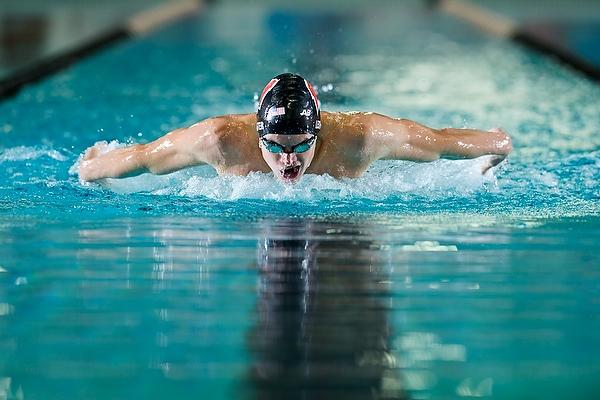While the water might be getting colder outside, the water inside of the Natatorium is getting hotter as the Wisconsin swimming and diving team prepares for their season to begin.
The Badgers are currently ranked 22nd in the country for men’s swimming, and women’s has managed to earn an impressive 12th place ranking overall, making them the second highest team in the Big Ten. Both men’s and women’s swimming had a great ending to their season last year, with several Badgers competing on the international level as well.
On the men’s side of things, Wisconsin lost one of their best swimmers, Matt Hutchins, this year. Although Hutchins is returning as a volunteer coach for UW this year, his spot still needs to be filled as the Badgers look for another freeform swimmer to take his place.
There are many options as to who might be able to fill the freeformer’s spot on the roster. Several swimmers, including Ryan Stack, Anthony Lyons and Eric Geunes have all shown promise throughout their careers at Wisconsin, and competed with Hutchins this summer at the U.S. Open.
The freestyle relay team manage to earn second at the U.S. Open in an extremely tight race. Wisconsin, who was up against California Aquatics were so close to earning first place, but were just one second behind the Californians, causing them to fall to second place.
The diving board will be taken care of by Kevin Pomeroy and Ethan O’Neill, who are both coming back from the summer after earning a spot in the USA Diving Championships. Pomeroy managed to earn second place while O’Neill earned third, impressive for a sophomore and a junior respectively.
The women are also set to start this season off well, with many swimmers competing in some sort of tournament this summer. Most notable is freestyler Cierra Runge, who managed to earn a gold metal at the FINA World Championships in Budapest this year.
Runge, a redshirt junior and transfer from Cal — most notably an Olympic Gold Medalist — earned gold at the 2016 Rio Games in the 800 freestyle relay. Last year, Runge placed seventh in the NCAA championship and also managed to break the school record in the 800 free relay.
Wisconsin has a challenging schedule this year, with the Badgers seeing many talented teams throughout the year. The start of the season is bound to be exciting, as the team heads down to Alabama to take on the No. 8 men’s and No.11 women’s team at Auburn on October 13th.
The Badgers get to return home the following weekend to take on Georgia at the UW Natatorium, who are currently the No.7 and No. 4 team in men’s and women’s swimming and diving, respectively.
Wisconsin also gets to meet their border rivals twice this year, once in Madison during a private meet between the two teams and then again the following week, when the Badgers head to Minneapolis to compete in the Minnesota Diving Invitational. These tournaments will take place on November 3rd and November 9th, so fans have plenty of opportunity to cheer on Wisconsin as they crush the Gophers.
Wisconsin’s schedule is tough this year, but this team looks at though they are ready to take on anything. Judging from all of the post-season success that the Badgers had this summer, this might be the year when teams should fear Wisconsin swimming and diving.
Odds are you might not know a lot about swimming. Don’t worry — because the Badger Herald has you covered. We’ll give you the lowdown on all that you need to know about swimming before the Badgers begin their season on the 13th.
Swimming can be broken down into the following categories: freestyle, backstroke, breaststroke and butterfly.
There is a fifth category of swimming in which the swimmer uses all four styles of swimming during their race. The swimmer starts the race off with the butterfly stroke, switches 1/4 of the way in to the backstroke, then to the breaststroke and finally to the freestyle.
Swimmers each have various lengths which they might swim, and many of the longer lengths will be in relay form. The swimmer who reaches the final length in the shortest amount of time is the winner.
On the diving side of things, there are three platforms that a diver might choose to jump from. There is a platform, which is a stationary board that provides no spring to help elevate the diver’s jump in the center, a 1-meter springboard and a 3-meter springboard, both of which are on either side of the platform.
Divers may choose to dive solo, or in groups of two or three, in what is known as synchronized diving. Divers are scored on various categories including: technique, quality of the dive, height the diver achieves and angle of entry.
While it might sound a little different than the swimming that you might have done during your elementary schools years, swimming and diving are both relatively easy sports to watch. Both tend to be very entertaining, and leaders can change in an instant.
Fans who want to support UW’s swimming and diving program are going to have to wait a week, since the Badgers first home meet is October 19th against Georgia. The two teams will meet in the UW Natatorium, as the SERF is currently under construction.
Correction: A previous version of this post had incorrectly stated various team members’ eligibility. The article has been updated to correctly reflect the team members’ eligibility. The Badger Herald regrets this error.


